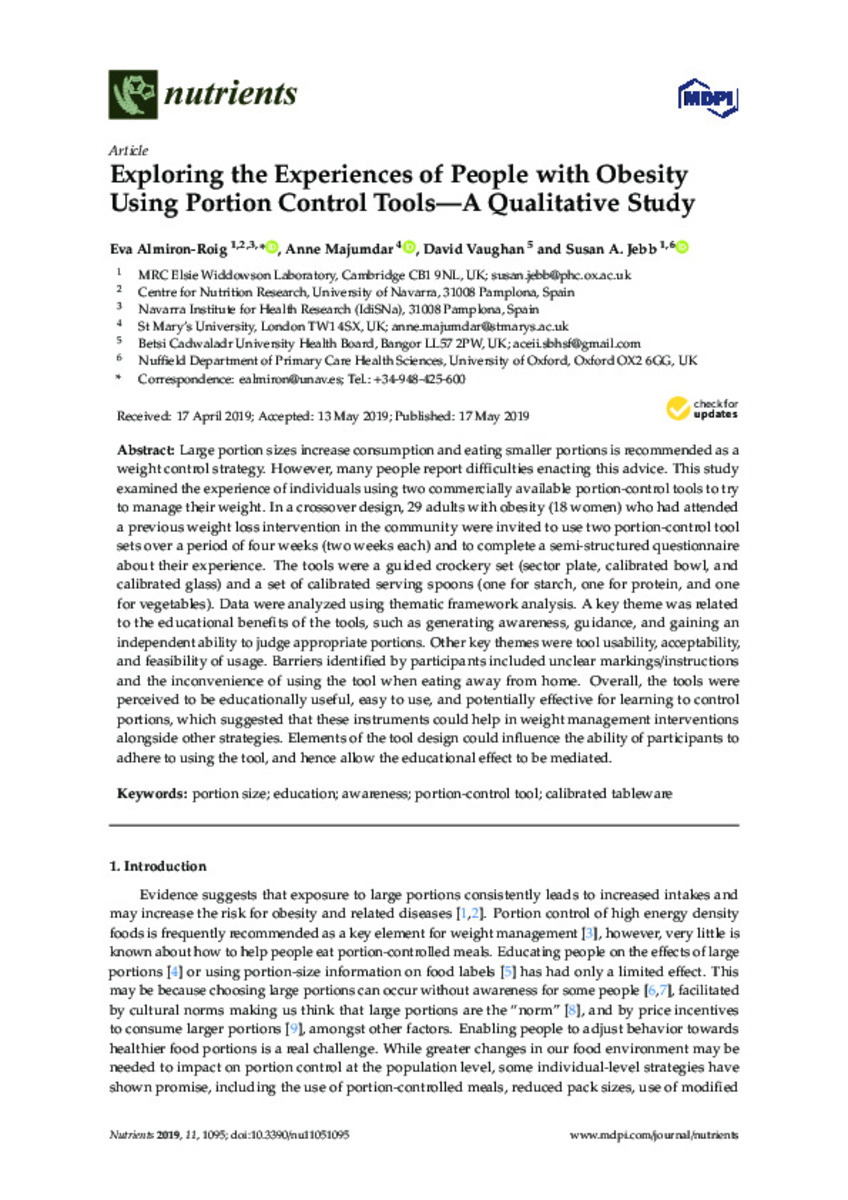Full metadata record
| DC Field | Value | Language |
|---|---|---|
| dc.creator | Almiron-Roig, E. (Eva) | - |
| dc.creator | Majumdar, A. (Anne) | - |
| dc.creator | Vaughan, D. (David) | - |
| dc.creator | Jebb, S.A. (Susan A.) | - |
| dc.date.accessioned | 2021-09-23T08:48:54Z | - |
| dc.date.available | 2021-09-23T08:48:54Z | - |
| dc.date.issued | 2019 | - |
| dc.identifier.citation | Almiron-Roig, E. (Eva); Majumdar, A. (Anne); Vaughan, D. (David); et al. "Exploring the Experiences of People with Obesity Using Portion Control Tools—A Qualitative Study". Nutrients. 11 (1095), 2019, 1 - 13 | es |
| dc.identifier.issn | 2072-6643 | - |
| dc.identifier.other | PMID: 31108869 | - |
| dc.identifier.uri | https://hdl.handle.net/10171/62049 | - |
| dc.description.abstract | Large portion sizes increase consumption and eating smaller portions is recommended as a weight control strategy. However, many people report difficulties enacting this advice. This study examined the experience of individuals using two commercially available portion-control tools to try to manage their weight. In a crossover design, 29 adults with obesity (18 women) who had attended a previous weight loss intervention in the community were invited to use two portion-control tool sets over a period of four weeks (two weeks each) and to complete a semi-structured questionnaire about their experience. The tools were a guided crockery set (sector plate, calibrated bowl, and calibrated glass) and a set of calibrated serving spoons (one for starch, one for protein, and one for vegetables). Data were analyzed using thematic framework analysis. A key theme was related to the educational benefits of the tools, such as generating awareness, guidance, and gaining an independent ability to judge appropriate portions. Other key themes were tool usability, acceptability, and feasibility of usage. Barriers identified by participants included unclear markings/instructions and the inconvenience of using the tool when eating away from home. Overall, the tools were perceived to be educationally useful, easy to use, and potentially effective for learning to control portions, which suggested that these instruments could help in weight management interventions alongside other strategies. Elements of the tool design could influence the ability of participants to adhere to using the tool, and hence allow the educational effect to be mediated. | es_ES |
| dc.description.sponsorship | This study was funded by the UK Medical Research Council, Program U105960384. SAJ is an NIHR Senior Investigator and is funded by the National Institute for Health Research (NIHR) Oxford Biomedical Research Centre and the Oxford NIHR Collaboration and Leadership in Applied Health Research. EA-R acknowledges support from the Center for Nutrition Research, University of Navarra. | es_ES |
| dc.language.iso | eng | es_ES |
| dc.publisher | MDPI AG | es_ES |
| dc.rights | info:eu-repo/semantics/openAccess | es_ES |
| dc.subject | Materias Investigacion::Ciencias de la Salud::Nutrición y dietética | es_ES |
| dc.subject | Awareness | es_ES |
| dc.subject | Calibrated tableware | es_ES |
| dc.subject | Education | es_ES |
| dc.subject | Portion size | es_ES |
| dc.subject | Portion-control tool | es_ES |
| dc.title | Exploring the Experiences of People with Obesity Using Portion Control Tools—A Qualitative Study | es_ES |
| dc.type | info:eu-repo/semantics/article | es_ES |
| dc.description.note | This article is an open access article distributed under the terms and conditions of the Creative Commons Attribution (CC BY) license (http://creativecommons.org/licenses/by/4.0/). | es_ES |
| dc.identifier.doi | 10.3390/nu11051095 | - |
| dadun.citation.endingPage | 13 | es_ES |
| dadun.citation.number | 1095 | es_ES |
| dadun.citation.publicationName | Nutrients | es_ES |
| dadun.citation.startingPage | 1 | es_ES |
| dadun.citation.volume | 11 | es_ES |
Files in This Item:
Statistics and impact
Items in Dadun are protected by copyright, with all rights reserved, unless otherwise indicated.






